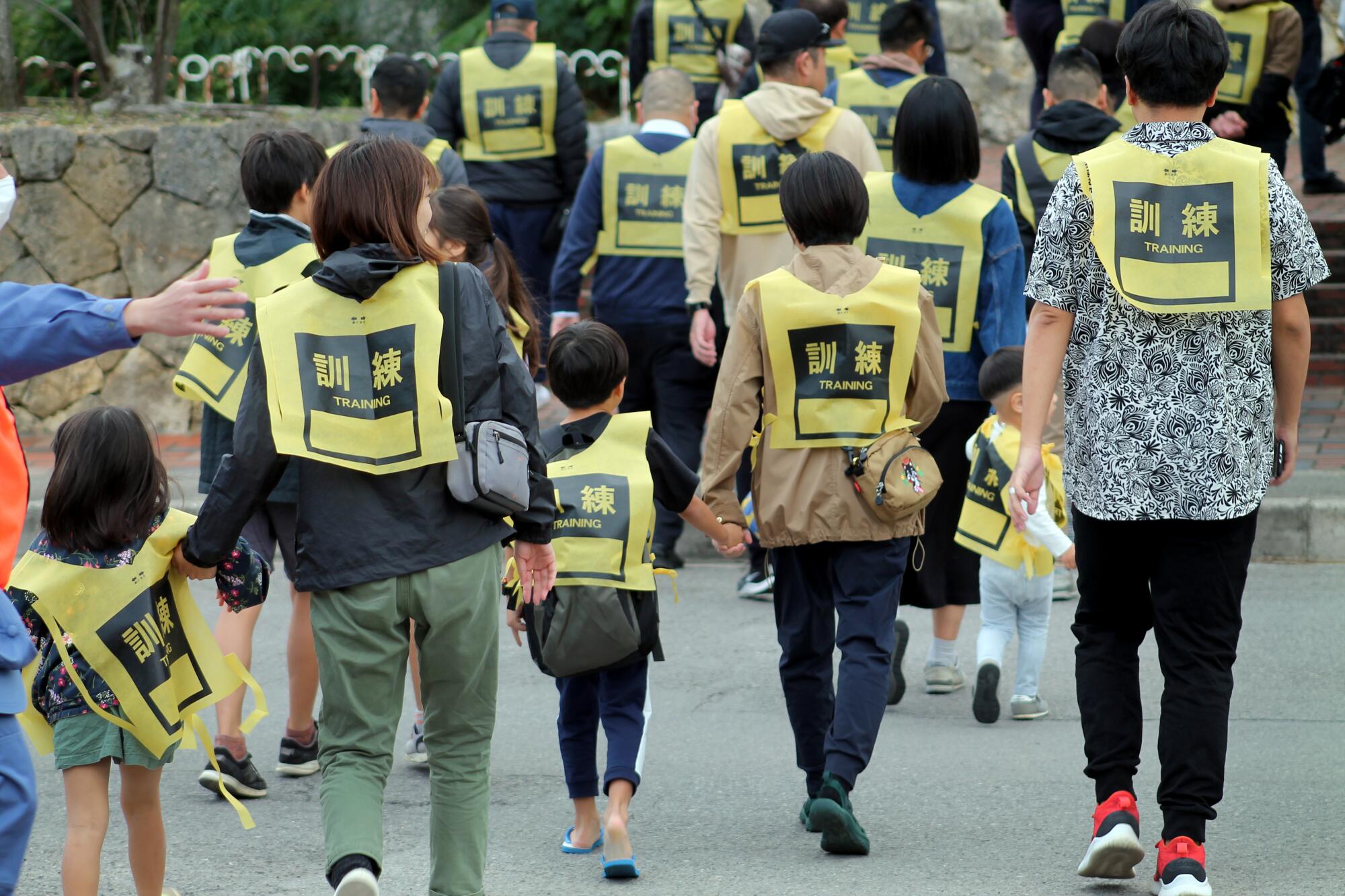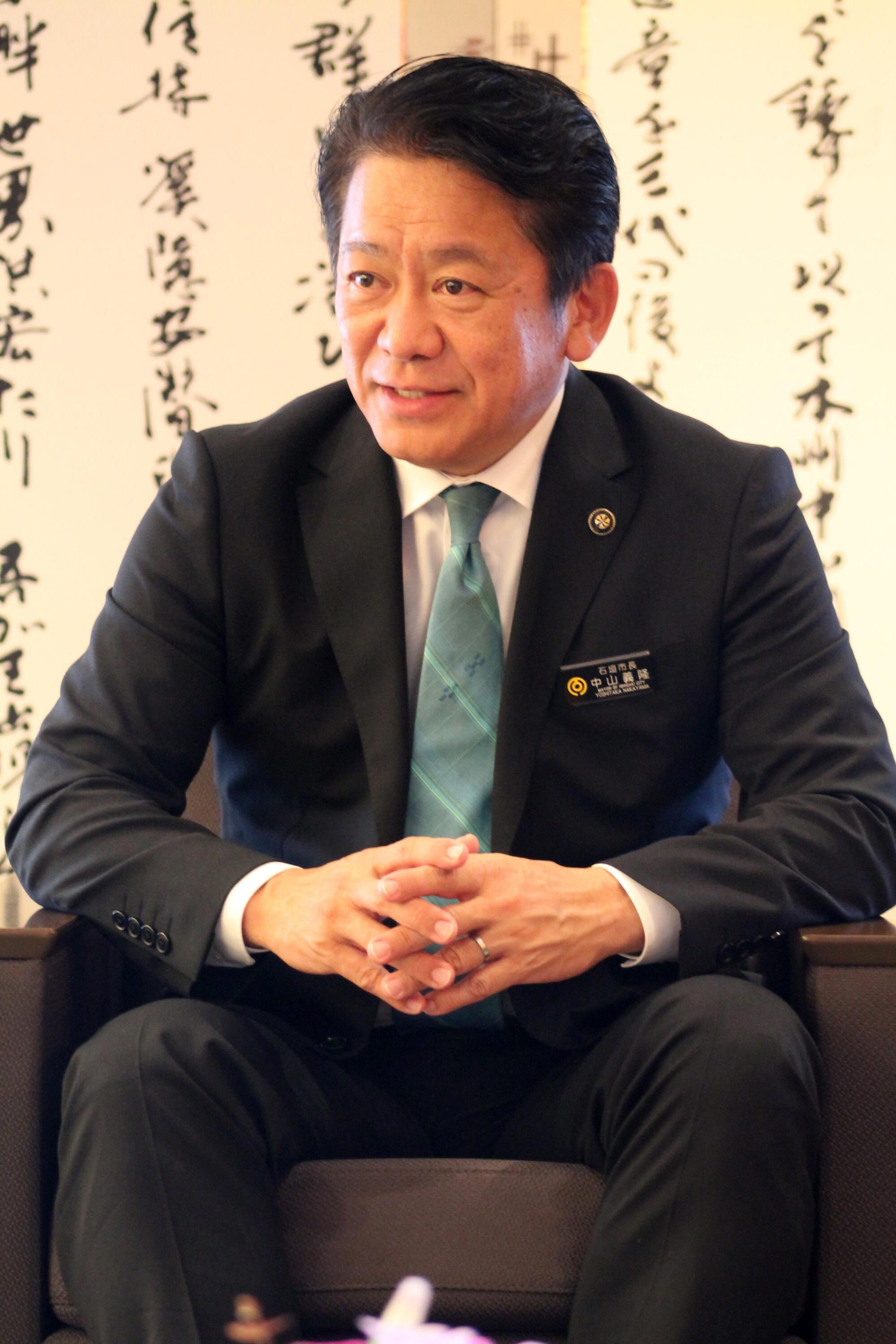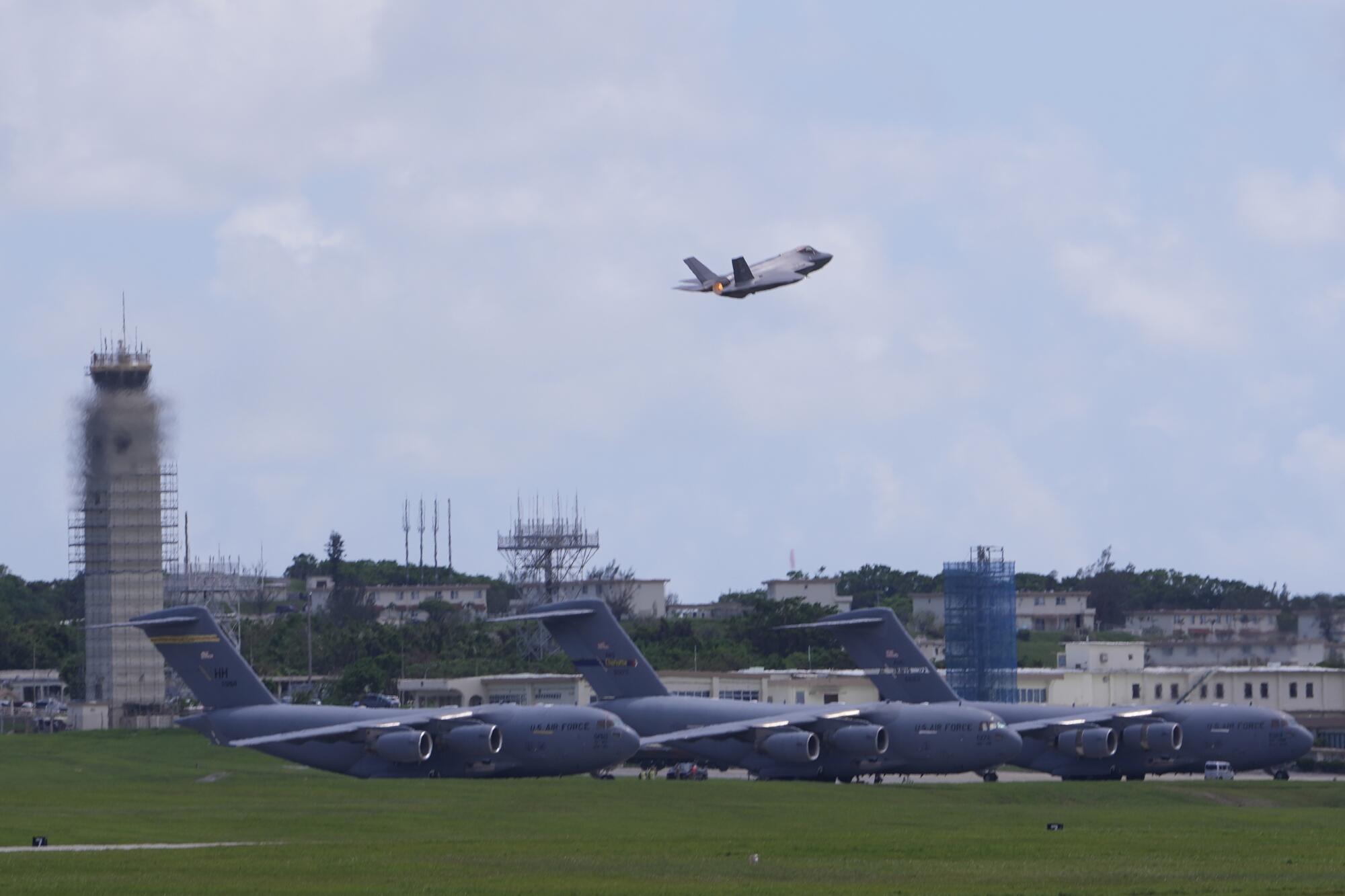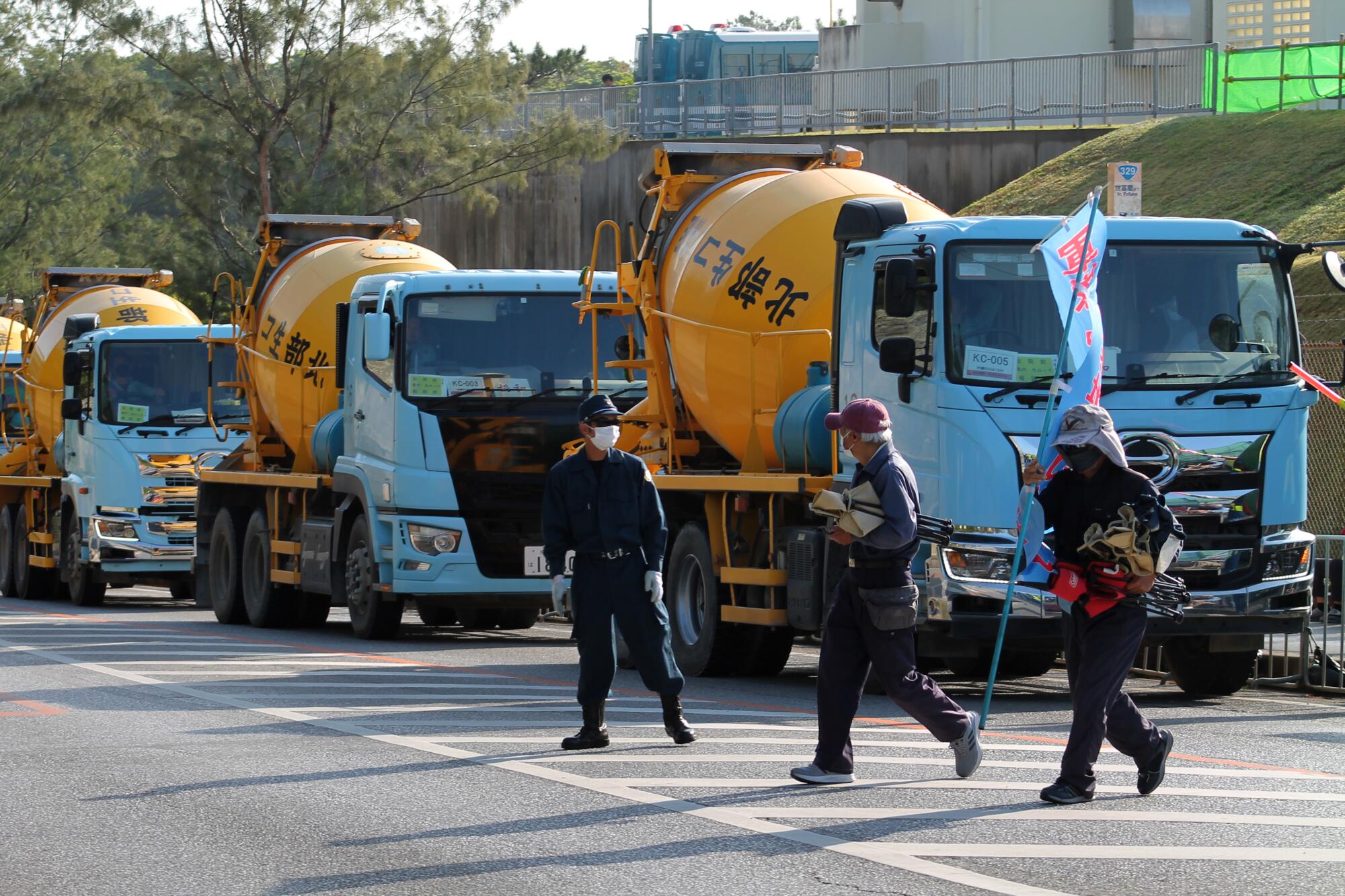
At the first blare of air raid sirens, the people milling about in a grassy park barely stirred. Five-year-old Tae Sano clung to her mother’s hand.
Some of the people around her, all wearing bright-yellow bibs, took a few uncertain steps. But the only real urgency came from a man in a blue uniform, jogging through the confused crowd.
“One more time,” he called out through a megaphone.
When the sirens wailed anew, a voice rang through the park: “A missile was just launched. Please evacuate immediately.”
This time, people moved. Ayako Sano led her three children to a nearby auditorium, where they crouched, hands over their heads, and waited for the drill to end. The exercise, the first for the island city of Ishigaki — closer to China and Taiwan than to the Japanese mainland — is being repeated across the country as increasingly restive neighbors heighten concerns about war.
“Nowadays, you never know what might happen,” Sano, a 37-year-old City Hall employee, said after the drill. “Not just in Ishigaki, but wherever you are in Japan.”
As geopolitical tensions in Asia grow more fraught, Japan has boosted military spending to record highs, and fear has permeated even some of the country’s most remote islands.
Incoming Taiwanese President Lai Ching-te must grapple with an increasingly fraught relationship with China that has edged closer to armed conflict.
“The threat is that Ishigaki is within range of North Korean and Chinese missiles,” said Mayor Yoshitaka Nakayama, who wants to expand the drill to an islandwide evacuation rehearsal. “It is important to strengthen our defenses, even though it may increase tensions.”
With the regional risks compounding, Japan has veered sharply from the anti-militarist stance it adopted after World War II. A defense strategy it released in December 2022 called for doubling military spending by 2027 and developing long-range missile capabilities.

Japan is building up its military bases — including in Ishigaki and nearby islands — and allowing the U.S. armed forces to expand an already extensive footprint in the nation. It’s trying to calm citizen protests over an increased troop presence and a debate over whether the expansion will draw more danger to Japan, rather than defend it. And it is preparing its people for worst-case scenarios, with hourlong drills like the one on Ishigaki.
While the secluded tropical tourist destination of Ishigaki may seem an unlikely target for attack, it is only 200 miles from Taiwan — the self-ruled island that Japan’s historical rival China claims as its own in increasingly aggressive displays.

After then-U.S. House Speaker Nancy Pelosi visited Taiwan in August 2022, Beijing launched an unprecedented series of military exercises and missile launches around that island. Five missiles landed near Ishigaki in Japan’s exclusive economic zone in Okinawa prefecture, which covers more than 150 islands between Taiwan and the Japanese mainland.
North Korea, an ally of China, also resumed firing missile tests into the waters around Japan that year.
Deteriorating relations between the United States and China have put Japan, a key U.S. ally, in a precarious position. The nation’s southwestern islands, near China’s eastern coast, could be among the first hit if the U.S. and China come to blows over Taiwan.
In Ishigaki, a new base for the Japanese military, known as the Self-Defense Forces, started operations last year. When construction began a few years ago across the road from his farm, Katsumi Toma questioned the need for the military outpost. But after seeing war break out in Ukraine and the Middle East, Toma, 31, changed his mind.
He now sees the camp as a necessity for the island’s protection. The fear that comes from living so close to an increasingly bellicose China supersedes his concerns that enlargement could infringe on his pineapple and sugar cane fields.

“I thought of war as something that happened far away,” Toma said. “If I could, I would oppose the camps. But the way things are going now, I don’t think we have a choice.”
The new Ishigaki camp has enabled the U.S. Marine Corps, which brought in a coastal unit last year, to start training drills around the island with Japanese troops. As its relationship with China has turned more adversarial, the United States has worked to bolster defensive partnerships with allies in the Asia-Pacific like Australian and Japan.
: :
Not all residents in parts of Japan that might be vulnerable have embraced this approach. Some 250 miles away from Ishigaki, wariness of both U.S. and Japanese militarization runs deep on the main island of Okinawa, which was devastated by the U.S. assault during World War II.
Scattered across the island, population 1.5 million, are stone memorials, abandoned bunkers and walls pocked with bullet holes — remnants of bloody battles between Japanese and American forces.
The United States ultimately wrested control and occupied the island for nearly three decades after Japan’s surrender. The U.S. returned Okinawa to Japan in 1971, but the bases remained and now account for 70% of U.S. military land use in Japan, even though the island represents just 0.6% of the country’s area.
That outsize presence has perpetuated resentment among locals, who have complained of noise pollution, environmental damage and misconduct by U.S. troops. Crimes by current or former U.S. service members — such as the kidnapping and rape of a 12-year-old girl in 1995 and the murder of a 20-year-old woman in 2016 — have sparked mass protests in Okinawa.

Okinawa’s governor is staunchly opposed to expanding U.S. and Japanese bases on the island. Denny Tamaki said his calls to move some U.S. operations off Okinawa have been overshadowed by the national government’s preoccupation with potential international conflict.
Tamaki, whose father was a U.S. Marine, has emphasized the need for Japan to maintain relations with Beijing as well as Washington.
“We understand that the security environment is becoming more and more severe,” Tamaki said. “But we are concerned that the increased level of deterrence could enhance risk in the region.”
Trade used to take precedence in Asia, but geopolitical tensions are now pushing nations into security blocs led by China and the United States.
Such worries are shared among some of his supporters — that as the military presence in Okinawa grows, it will inevitably attract the ire of enemy nations. Plans for a new Japanese base in central Okinawa have been met with local anxiety and resistance.
“With so many Japanese and U.S. military bases here, we would be hit immediately,” said Rinichi Teruya, a 71-year-old innkeeper who grew up in the Okinawa town of Kadena, next to the largest U.S. Air Force base in Asia.
Teruya has fond memories of American soldiers, recalling that they would often walk with him and share their bananas and Sunkist oranges.

That did not stop him from joining demonstrations against the bases later in life. While his age prevents him from protesting now, he believes that expansion will inflame frictions between U.S. military personnel and locals over issues like excessive noise, vehicular accidents and pollution.
On a balmy February morning, two dozen protesters sat in front of the gates of a U.S. Marine Corps camp on the coastal area of Henoko in the center of the island, obstructing entry for a growing line of cement trucks.
They held signs calling for a halt to the construction of a relocated air station within the base and chanted against Japan’s Ministry of Defense.
Biden sought to smooth over tensions with China’s Xi, who said conflict with the U.S. has ‘unbearable consequences’ for both countries.
Despite their daily dedication to delaying work on the military facility, the average age of the protesters — about 70 — suggested a stagnating activist movement even as fears of conflict have grown.
“People who remember the war are gone. The movement is shrinking,” said Hiroe Shimabukuro, a 47-year-old resident who participated in similar protests there when she was in her 20s.
Work and raising her young son have left her little time for political activism. But alarmed by what she sees as the nation’s march toward war, in which Okinawa could be sacrificed once again, she started wearing yellow — clothes, ribbons — as a warning and a call for awareness.
“Many people are not aware of what is going on,” she said. “Militarization happened too fast. People couldn’t catch up.”

While she promotes the fledgling movement on social media and at antiwar events, Shimabukuro feels the need to do more and wishes younger people would get more involved, she said.
Opinion polls show that Okinawans under 40, accustomed to U.S. bases, are less fervently opposed to them than their elders.
Kanato Shimoji, a 19-year-old majoring in psychology at Okinawa International University, said though he often sees criticism of the U.S. military in local media, he harbors little animosity.
“I think the very existence of the U.S. military bases is a deterrent that will keep Okinawa from going to war,” Shimoji said. “I don’t know what might happen if the bases were really gone.”
The Japanese military is mounting a major exercise on Hokkaido island in a display of might amid a recent increase in Chinese and Russian maneuvers.
Haru Goya, 23, said she worries about Okinawa’s proximity to China and its isolation in the event of a military assault. Still, the concept of war feels foreign to her, even after learning about the Battle of Okinawa in school and hearing wartime tales from her grandmother.
“We see it differently from our grandmothers and grandfathers who experienced war,” said Goya, who sells knitwear and accessories. “We have not experienced the dark side of history.”
: :
In Ishigaki, there are fewer scars, less constant reminders of war, and most remain sanguine about the prospect of attack. But those who remember have been unnerved by the military’s return to the small island.
Setsuko Yamasato, who grew up on the island, had lost half her family to the tumult of World War II by the time she was 8.
In 1944, her older brother was en route to serve in the military when his boat was sunk by a U.S. missile. The following year, her infant sister died of starvation while they sheltered in the wilderness from air raids, and her mother and grandfather succumbed to malaria.

Now 87, Yamasato spends Sunday evenings protesting in front of the Japanese military camp and other spots across the island, holding signs and waving and shouting to passing, honking motorists. She is sure that the growing presence of Japanese troops is more likely to bring conflict than to protect from it.
“Through our experience in the war, the military forces didn’t save the island people,” she said.
Only a few elderly locals ever join Yamasato in her weekly protests, and she sees their efforts as a prayer for peace more than anything else.
If war does reach Ishigaki’s shores again, Yamasato has no plans to leave.
“This is where I was born and raised, not by my parents or grandparents, but by this entire island,” she said. “If I have to be baptized by fire, that would be my destiny.”
Special correspondent Makiko Segawa contributed to this report.
More to Read
Start your day right
Sign up for Essential California for news, features and recommendations from the L.A. Times and beyond in your inbox six days a week.
You may occasionally receive promotional content from the Los Angeles Times.











